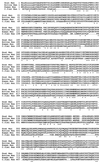Mannan-degrading enzymes from Cellulomonas fimi
- PMID: 10347049
- PMCID: PMC91384
- DOI: 10.1128/AEM.65.6.2598-2605.1999
Mannan-degrading enzymes from Cellulomonas fimi
Abstract
The genes man26a and man2A from Cellulomonas fimi encode mannanase 26A (Man26A) and beta-mannosidase 2A (Man2A), respectively. Mature Man26A is a secreted, modular protein of 951 amino acids, comprising a catalytic module in family 26 of glycosyl hydrolases, an S-layer homology module, and two modules of unknown function. Exposure of Man26A produced by Escherichia coli to C. fimi protease generates active fragments of the enzyme that correspond to polypeptides with mannanase activity produced by C. fimi during growth on mannans, indicating that it may be the only mannanase produced by the organism. A significant fraction of the Man26A produced by C. fimi remains cell associated. Man2A is an intracellular enzyme comprising a catalytic module in a subfamily of family 2 of the glycosyl hydrolases that at present contains only mammalian beta-mannosidases.
Figures







References
-
- Alkhayat A H, Kraemer S A, Leipprandt J R, Macek M, Kleijer W J, Friderici K H. Human β-mannosidase cDNA characterization and first identification of a mutation associated with human β-mannosidosis. Hum Mol Genet. 1998;7:75–83. - PubMed
-
- Bauer M W, Bylina E J, Swanson R V, Kelly R M. Comparison of a β-glucosidase and a β-mannosidase from the hyperthermophilic archaeon Pyrococcus furiosus. J Biol Chem. 1996;271:23749–23755. - PubMed
-
- Béguin P, Gilkes N R, Kilburn D G, Miller R C, Jr, O’Neill G P, Warren R A J. Cloning of cellulase genes. Crit Rev Biotechnol. 1987;6:129–162.
-
- Béguin P, Lemaire M. The cellulosome: an exocellular, multiprotein complex specialized in cellulose degradation. Crit Rev Biochem Mol Biol. 1996;3:201–236. - PubMed
Publication types
MeSH terms
Substances
Associated data
- Actions
- Actions
LinkOut - more resources
Full Text Sources
Other Literature Sources
Molecular Biology Databases

